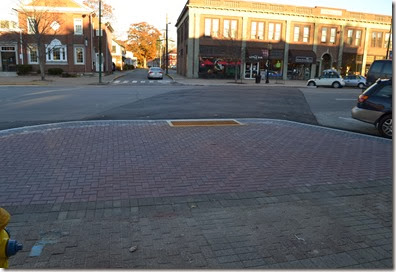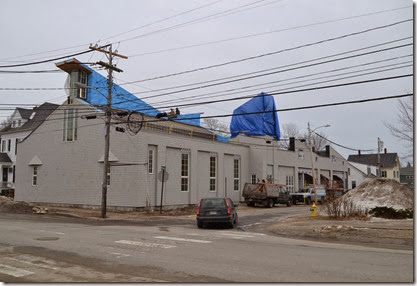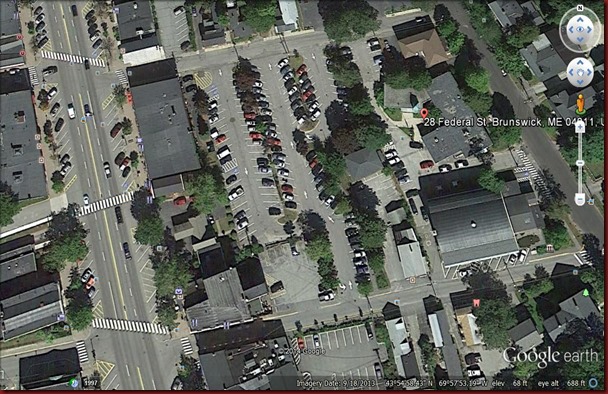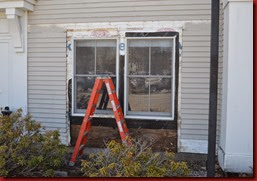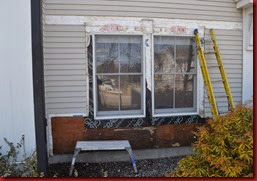Every now and then the fates align, providing a rare opportunity for our perfect little town to rise above the riff-raffery of monotonous municipal mundanity. Opportunity briefly knocks, offering Lake Basebegone the chance to find it’s place in the pantheon of the global placemaking movement.
The recent embrace of raised crosswalks as a traffic calming measure, and back in parking (rejected by the unenlightened) before that, establish our willingness to do anything, to pay any price, to make a name for ourselves. Not necessarily a good name, but a name nonetheless.
It’s Time for a Reality Check
We are now in the “Age of Amtrak” phase of making a place of ourselves. This calls for one of our broken record reminders: Henry Hazlitt’s ‘economics in one lesson,’ which reads as follows:
“The art of economics consists in looking not merely at the immediate but at the longer effects of any act or policy; it consists in tracing the consequences of that policy not merely for one group but for all groups.”
We’re here to propose looking at effects and tracing consequences of very specific acts and policies. Especially as they relate to both “sides” of town.
Any guesses what we might be referring to? If you haven’t figured it out yet, here are some clues.
Pertinent Background
Feast your eyes and your sensibilities, if you have any, upon these morsels of Downeaster related nutrition:
- “It’s change. It will be an adjustment, I’m not denying that,” said (Margo) Knight. “But the service to Brunswick has done amazing things already for the businesses downtown.” (March 2013). Keep in mind the service began just 4 months earlier.
- "People are very excited about the train service being here and are excited about the increased train service," she said. (Margo Knight; September 2013)
- Petrillo’s in Freeport, adjacent to the station there, reportedly has experienced ‘at least a slight uptick’ in their business, which sounds like scripted spin for ‘no tangible benefit.’
- PORTLAND (AP) — Amtrak’s Downeaster train carried nearly 50 percent more passengers on its expanded Portland-to- Brunswick route than rail officials expected in the first year of the service. The numbers for the new line show that north of Portland, two-thirds of the passengers boarded in Brunswick, while the rest boarded in Freeport. (November 2013)
- We’re not sure whether that means Brunswick has had a massive population outflow or what.
- Former Town Councilor Margo Knight noted that while a train is a “powerful economic engine,”…. (April 2014)
- Last election season, we published a ‘candidate forum.’ One of the questions we asked was this: Do you believe the Amtrak train, all things considered, has provided an economic benefit to Brunswick? Please explain your reasons for your position.
- Benet Pols, now the Council Chair, answered this way: Who knows? There's no objective data at all.
- The service currently carries about 150 passengers a day on the part of the route north of Portland , Quinn said.” (Against a capacity of about 1200)
- Question: If we ride from Brunswick to Freeport to Portland in the morning, and back from Portland through Freeport to Brunswick later in the day, how many ‘passengers’ are we counted as? One? Two? Four?
- NNEPRA FY13 Annual Report figures (http://www.nnepra.com/sites/default/files/NNEPRA2013AnnualReport_web.pdf:
- food service revenue was $611,812; food service operating expenses were $773,420. That’s a loss of 21% on food service.
- total operating revenue was $9,182,012 against total operating expenses of $16,762,301. That’s an operating loss of 45% overall - $7.5 million. With ample reason to expect the loss will grow in the current year and in the future.
- In round numbers, fares on the Downeaster would have to double for the operation to approach financial ‘sustainability.’ What effect would that have on ridership?
- Capacity for riders between Portland and Brunswick is 1200 per day with two round trips. Average ridership (143 per day) is barely 12% of this capacity, yet we hear constant talk of ‘expanding service to Brunswick.’
- MLF is ‘required’ to store trains in Brunswick because of severe limits on track slots between Brunswick and Portland; how can service be expanded?
Clarity, we say, clarity. That’s what we need, now more than ever.
A Rare Opportunity
The Downeaster has been running between Brunswick and Portland for 18 months. As noted above, local officials were issuing rave reviews (“amazing things already for the businesses downtown”) within four months of service initiation. Having been in operation through all four seasons and more, we think it’s high time that a serious, disciplined look at the economic promises and realities of Downeaster service be undertaken.
Brunswick is uniquely positioned to get to the heart of this challenging subject. We’re home to Bowdoin College, which has a strong devotion to service learning and community involvement for the common good. (http://www.bowdoin.edu/academics/common-good/index.shtml) Not to mention that it employs some of the finest minds in economics and socio-political studies.
The community, for its part, embraces the excellence of the local academy in all regards, and reveres its contributions to economic and social justice, the advance of human knowledge, and its elevation of town character.
This symbiosis provides a unique opportunity for all to benefit by leveraging the town/gown connection. Rarely does such synergy and objectivity present itself as a resource to bring clarity to the facts of our circumstances, while providing an unprecedented learning opportunity for students and their faculty.
The Challenge
We see the key participants in this quest as the Brunswick Town Council; the town Economic Development Office; the Brunswick Downtown Association; Bowdoin administration; Bowdoin faculty; and the Bowdoin student body.
And we see the challenge as addressing the pyramid of human comprehension: data, information, knowledge, understanding, truth, and finally, wisdom.
We look to those like Professor David Vail (Emeritus) of the Bowdoin Economics Department. He’s been a leading voice on the subject of sustainability, and has also participated in various tourism studies. Some years back, he was one of a rotating group of columnists who provided commentaries on sustainability to the local newspaper.
Further, we hope Professor Christian Potholm of the Government and Legal Studies Department might have an interest in advising on the socio-political aspects of this subject.
It goes without saying, of course, though we are saying it anyway, that this is clearly a superb, real-life learning experience for Bowdoin students under the guidance of nationally recognized faculty mentors.
In keeping with the common-good motivation, we expect all related efforts to be on a non-paid, voluntary basis, though we expect some students could earn credits for meaningful research projects in their major field of study.

Analysis Topics
We’ll be very brief for now; we’re anxious to get this subject ‘out there.’ But we commit to providing a more robust outline of study structure soon for all to see.
For the moment, here are the areas we see as at the head of the list:
- Surveying/cataloging downtown businesses
- Identify those that could experience benefit
- Identify those that would not: banks, dentists, optometry, dry cleaners, jewelers, beauty salons, outer Pleasant Street, Cooks Corner, etc
- Identify/quantify declines as well as increases in economic activity; eg, Concord Coach
- Discretionary entertainment funds flowing to Portland, Boston, take away from Brunswick region
- How many were traveling by car or bus before train, and simply switched modes; no net increase/decrease; simply modality
- Freeport and Brunswick: which way money is flowing
- Identify/quantify local capital outlays and recurring operating expenses
- Establish methodology for accurately assessing ridership
- how to count v. stations checked off
- passengers v. tickets
- exclude all Bowdoin students/staff
- unless you are moving, round trips are the norm, which means each time you sign up for the train, you count as at least two riders. eg: 52,000 riders for the year is really 26,000 individuals
- Compare bus service: costs, flexibility, schedule, convenience, carbon footprint, connections
- bus ridership
- Compare use of personal vehicle
- Document those asking for expanded service as described in annual report
- Assess consequences of Brunswick as a dead end destination: would cost $20 million more to get trains 3 miles to the North to Cooks Corner area.
- What the town could do with the $100,000 in annual operations support…calculate ROI against restaurant gross
- Testing the assertions of NNEPRA:
The response to the limited Downeaster service to
Freeport and Brunswick has been overwhelmingly
positive, exceeding daily average ridership projections
by 50% in the first 8 months of operation and generating
millions of dollars in economic impact. Municipalities,
tourism organizations, private businesses, developers
and others along the entire Downeaster corridor are
encouraging NNEPRA to add more trips to meet
growing demand. Of significance, ridership on the first
northbound train (681/691) increased by an average of
38% in FY13, and the last southbound train each day
(688/698) increased by an average of 73% in FY13.
Both trains serve Freeport and Brunswick, clearly
indicating that the expansion of service is generating
ridership on previously low-performing trains.
From: http://www.nnepra.com/sites/default/files/NNEPRA2013AnnualReport_web.pdf
The Bottom Line
We believe that in the ‘executive summary’ version of this proposed effort, the merits of Downeaster service to Brunswick can be reduced to two metrics (or parameters, if you prefer.)
1) Net Effective Adult Daily Discretionary Passenger Flow (volitional train riders).
What do we mean by this term? First, it means that children below a certain age riding with paying adults do not matter from a measuring ridership perspective; they are not travelling of their own free will. And it also means that ‘volunteer train riders’ like those from TrainRiders Northeast don’t count.
Second, it means that if you were going to make your trip anyway, and simply chose to use the train instead of the bus or an auto, your ridership is irrelevant. You were making the trip regardless, and the train had nothing to do with causing it. For example, if you’re a Bowdoin student or staff member, your travel on the train was a matter of choosing from the available options; you were coming here/returning here anyway.
Third, the term ‘net’ means the difference between those who consider Brunswick and environs as their ‘home’ station, and those who consider Portland (or points south) and environs as their ‘home station.’ If there are 75 of each in a given day, the ‘net’ is zero.
2) Net Effective Daily Dollar Flow
What do we mean by this? We simply mean that some passengers are visitors to the local area and are bringing/spending discretionary dollars here. Other passengers inhabit the local area, and are bringing/spending discretionary dollars elsewhere. To understand the marginal economic activity caused by the Downeaster, one must carefully examine both figures. If an incoming visitor on the train was going to come to the area regardless, the fact that he/she rode the train is irrelevant in terms of economic activity. On the other hand, if a Bowdoin student or staffer takes the train south, or any other area resident does, the dollars they spend elsewhere are lost as potential expenditures here in town.
The ‘net’ flow is the difference between economic activity by visitors here in town, and the same activity in points south by those departing from this region.
If this all seems inarticulate and confusing, forgive us. We know exactly what we mean, and trust that the economists in our midst can sort it all out.
===========================================================
Follow up study for “the interested student:”
“The Amtrak Inspector General has confirmed that Amtrak cooked the books to cover up food service losses that now approach $1 billion dollars,” Mica said.
Trains run by states in Maine and Alaska using private contractors have significantly lower labor costs than Amtrak does with its dining service employees, Alves said. The states pay $7.75 to $13 an hour with no benefits, compared with $41.19 including benefits for an on-board Amtrak employee.
